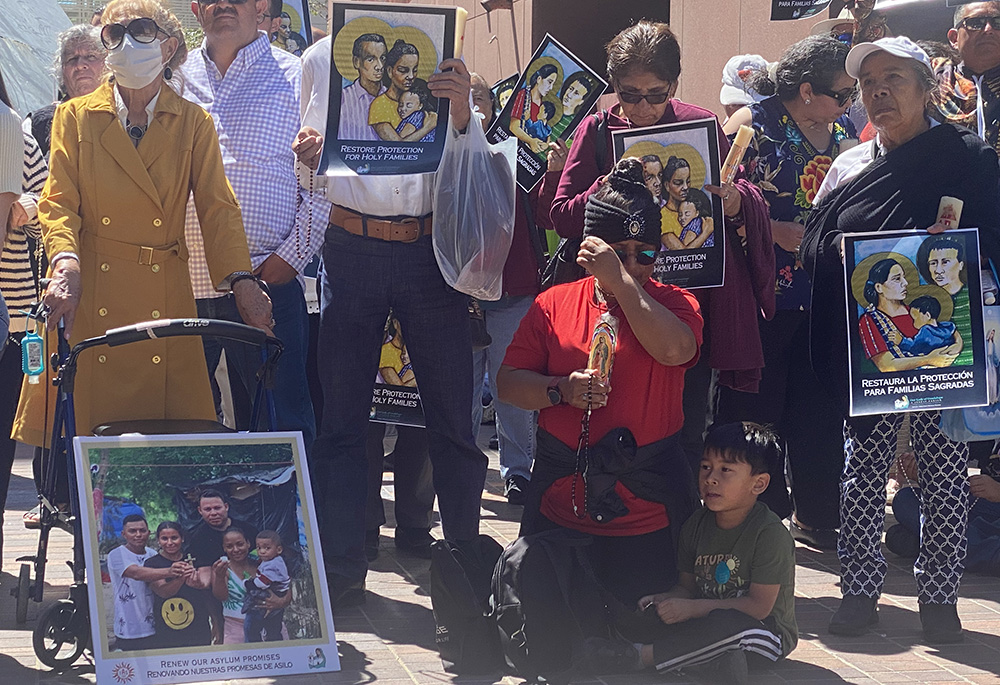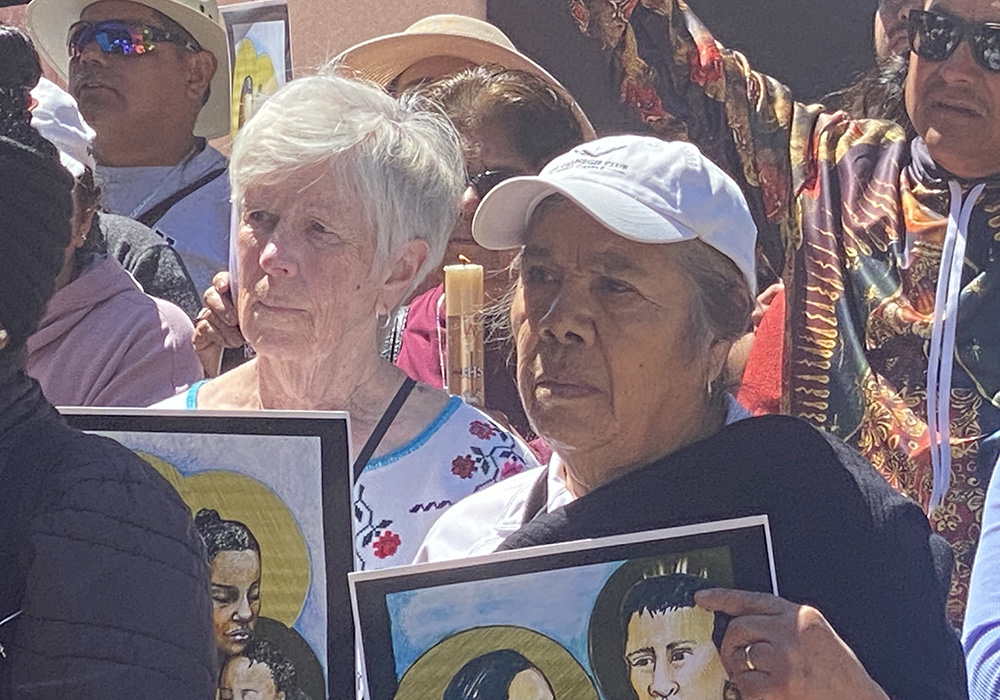
Members of Our Lady of Guadalupe parish gathered to pray for better asylum laws May 7 outside of a federal building in downtown San Diego that houses U.S. Immigration and Customs Enforcement. The church's pastor, Jesuit Fr. Scott Santarosa, led the group there after noon Mass, where parishioners prayed for those killed and injured when a car ran into a crowd outside a migrant center in Brownsville, Texas. (NCR photo/Rhina Guidos)
Tensions were already high at the U.S.-Mexico border and they escalated May 7 after a car ran into a crowd outside a Brownsville, Texas, building that provides shelter to migrants, leaving eight dead and at least 10 injured.
Brownsville Bishop Daniel Flores tweeted a few hours later that he and Auxiliary Bishop Mario Avilés celebrated Mass outside the building "to offer consolation to the immigrants and staff." Flores asked for others to "pray for those who saw it happen; they are devastated."
A video posted on various social media platforms shows a group of men gathered in a grassy area, near the Bishop Enrique San Pedro Ozanam Center, when a car slams into them, sending some people into the air. The Brownsville Diocese said in a statement that the center has "served the homeless and immigrants for decades."
The driver of the vehicle was hospitalized; local authorities say they are preparing to place the person in custody. They are also trying to determine whether the incident was deliberate since it took place as border towns, including Brownsville, experience a surge of migrants, as well as a surge of acrimony, days before a controversial federal health rule ends on May 11.

Mercy Sr. Mary Waskowiak, left in white, joins members of Our Lady of Guadalupe parish as they pray May 7 for compassionate asylum laws in front of the federal building that houses U.S. Immigration and Customs Enforcement in downtown San Diego. Almost 200 attended the event, which marks the start of a novena May 7-12, an effort by Jesuit organizations calling on the government to provide refuge to those seeking it. (NCR photo/Rhina Guidos)
Title 42 of the Public Health Service Act, implemented during the Trump administration, has kept thousands of asylum-seekers out of the U.S. since the coronavirus pandemic began in early 2020. It allowed border patrol agents to rapidly expel those seeking to apply for asylum, saying it was necessary to turn them away to control the spread of Covid-19.
But many suspected deterrence was the real reason the Trump administration first enacted it. Legal challenges against the Biden administration's efforts to end the measure had kept Title 42 in place. But with organizations such as the World Health Organization calling an official end to the coronavirus emergency May 5, there's little justification to keep it in place.
Upon hearing the news of the rule's demise, tens of thousands of migrants have taken to border towns such as Ciudad Juarez and Tijuana on the Mexico side, thinking that the end of Title 42 means an opportunity to enter.

Natalie Gonzalez, 7, holds a sign May 7 in front of the federal building that houses U.S. Immigration and Customs Enforcement in downtown San Diego as members of Our Lady of Guadalupe parish pray for compassionate asylum laws. (NCR photo/Rhina Guidos)
Some Catholic parishes, including Our Lady of Guadalupe in San Diego, began a novena May 7 "to renew our asylum promises," an effort by Jesuit organizations calling on the government to provide refuge to those seeking it.
After Sunday's noon Mass on May 7, where parishioners prayed for those killed and injured in Brownsville, the church's pastor, Jesuit Fr. Scott Santarosa, led a group of parishioners to a federal building in the city to pray for more "just and compassionate" laws, speaking out against Title 42.
"Why are we here? We're here because we want to put our bodies where our hearts are and our hearts are with migrants," said Santarosa in Spanish. "And we want to put our bodies here in this place, where laws are applied, and where migrants seek asylum."
He said the parish was there to exercise its faith and to put it into action by being on the side of families and of migrants because it wasn't enough just to plead in church for changes.
Many Catholics, including the U.S. bishops' conference, opposed Title 42. Groups of women religious also spoke against it and demonstrated outside the White House during the Trump and Biden administrations. But its end doesn't mean that everyone who asks for asylum will be allowed in.
Advertisement
"I would expect a significant increase in expedited removals," meaning a rise in deportations, said Sr. Ann Durst, a Catholic sister and immigration lawyer, who founded Casa Cornelia Law Center, a legal nonprofit in San Diego that helps migrants.
"At a human level, there's a sadness," Durst, a member of the Society of the Holy Child Jesus, told NCR on May 6. "These people have moved up through Mexico, some coming through the Darien Gap, suffered a lot, they've been living in the streets, in Mexico, Tijuana, and they've been waiting to apply for asylum. Most of these folks have no idea that they're not going to get it."
While ending Title 42, the Biden administration has been moving toward getting asylum-seekers to apply for refuge in countries other than the U.S. as well as getting would-be migrants to use immigration processing centers in Colombia or Guatemala, seeking to screen them outside the U.S. and determine whether they qualify to enter the country legally. They're touting a variety of programs, including family reunification or work programs, seeking to deter irregular immigration into the country.
Immigration attorney Carmen Chavez, executive director at Casa Cornelia Law Center, said Title 42 created a bottleneck for three years, "and now it's like this." News reports show migrants sleeping on cardboard boxes in the streets of border towns such as El Paso and many sneaking through the border along the Rio Grande.
"My concern is that not enough resources are going to be mobilized," Chavez said, from the government providing enough people to process claims to law enforcement presence as migrants prepare to cross the border.
Meanwhile, cities such as Brownsville now have added sorrow to deal with, as some condone online the violent end that befell the migrants, even as questions about the incident remain to be answered.
"We must resist the corrosive tendency to devalue the lives of immigrants, the poor, and vulnerable," Flores said in a statement released by the diocese. "As we await a fuller report from law enforcement authorities, let us stop for a moment to mourn these losses of life and to pray. Pray for the victims, pray for their families and loved ones, and pray for our community. And after we pray, let us continue our common efforts to serve those most in need."






